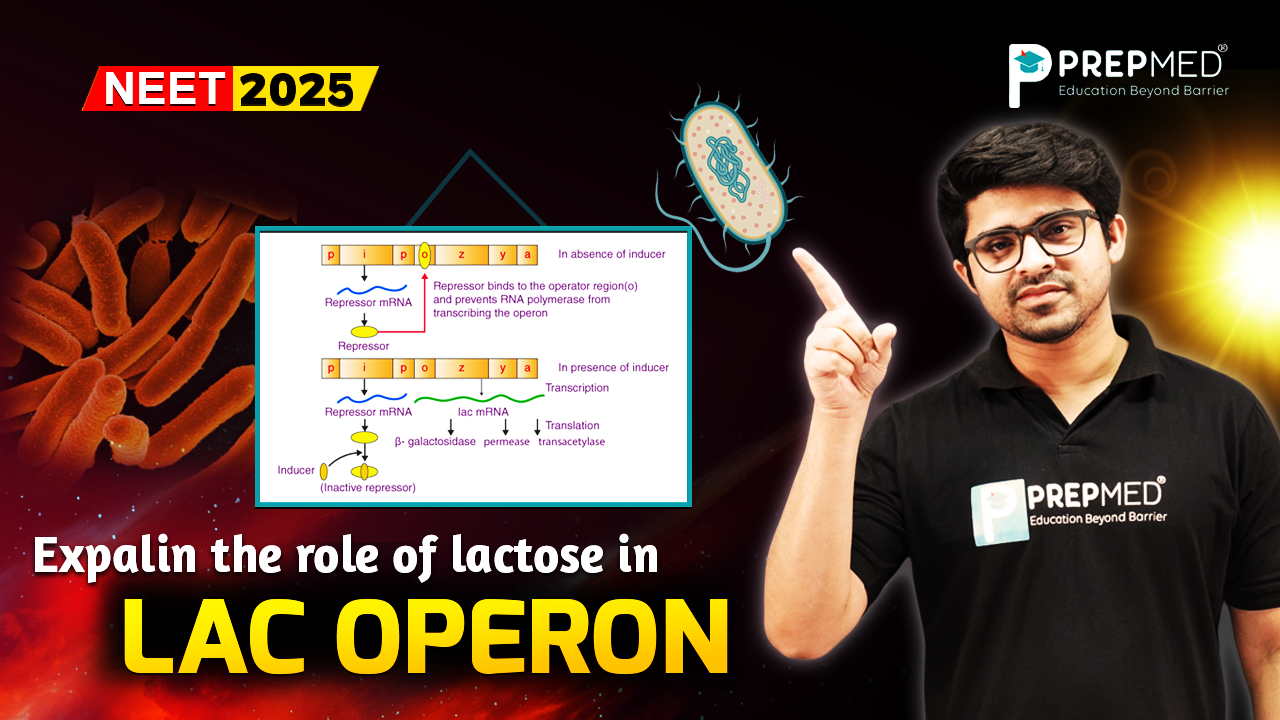April 03, 2025
Explain the Role of Lactose in Lac Operon
The Lac Operon is one of the most well-studied gene regulation mechanisms in prokaryotes, particularly in Escherichia coli (E. coli). The Lac Operon functions as an essential model to study how cells control gene expression during environmental adjustments. The primary function of the Lac Operon is to enable bacterial cells to metabolize lactose when glucose, their preferred energy source, is unavailable.
This blog explains the role of lactose in Lac Operon, detailing the molecular mechanisms, the interaction of inducers and repressors, and how RNA polymerase functions in gene expression. Additionally, NEET-level multiple-choice questions (MCQs) and concept boosters are included to strengthen your understanding of Lac Operon, Lac Operon explained, RNA polymerase structure, Lac Operon diagram, and what is Lac Operon.
Lac Operon Mechanism
The Lac Operon consists of three structural genes:
- lacZ gene: Produces β-galactosidase that breaks down lactose into glucose and galactose molecules.
- lacY: Encodes lactose permease, which facilitates the transport of lactose into the bacterial cell.
- lacA gene: Encodes transacetylase, which seems to detoxify lactose metabolism by-products, although its precise role remains unknown.
A promoter, together with an operator and the regulatory gene (lacI), controls these structural genes. The operon uses both negative and positive regulatory mechanisms to activate lactose metabolism efficiently when lactose is present.
Step-by-Step Lac Operon Mechanism
1. When Lactose Absence Occurs, the Operon Becomes Inactive (Negative Regulation)
- The lacI gene functions to consistently create the lac repressor protein.
- This repressor binds to the operator region of the Lac Operon.
- The promoter area becomes inaccessible to RNA polymerase, thus blocking the transcription process.
- The absence of transcription prevents the synthesis of β-galactosidase and permease, and transacetylase enzymes needed for lactose metabolism.
Key Point: The Lac Operon is normally turned off when lactose is absent, preventing unnecessary enzyme production.
2. In the Presence of Lactose: Operon is Turned On (Induction Mechanism)
- After lactose enters the bacterial cell, the first step converts some of it to allolactose, which functions as an activator.
- The allolactose molecule attaches itself to the repressor protein, making it unable to bind to the operator region.
- Without the repressor blocking the operator, RNA polymerase can bind to the promoter and transcribe the Lac Operon genes.
- The synthesis of β-galactosidase permease and transacetylase becomes possible after the operator becomes accessible.
Key Point: The inducer lactose disables the repressor protein, which enables the transcription of genes.
3. The Role of Glucose: Catabolite Repression (Positive Control by CAP-cAMP)
Even when lactose is present, the Lac Operon does not function optimally if glucose is available. Bacteria choose to use glucose instead of lactose because the energy requirements for metabolising glucose are lower.
- The cell generates high amounts of cyclic AMP (cAMP) during periods of low glucose concentration.
- The catabolite activator protein (CAP) becomes activated through its binding with cAMP.
- The CAP-cAMP complex binds to the promoter, enhancing RNA polymerase structure binding and increasing transcription of the Lac Operon genes.
- If glucose is high, cAMP levels drop, preventing CAP from binding and leading to reduced Lac Operon activity.
Key Point: The Lac Operon is fully active only when lactose is present and glucose is scarce.
Role of Lactose in Lac Operon Regulation
Lactose acts as an inducer in the Lac Operon system. In the absence of lactose, the lacI gene produces a repressor protein that binds to the operator region of the Lac Operon, blocking RNA polymerase from transcribing the structural genes. The absence of lactose metabolism enzymes prevents the body from wasting energy because enzyme synthesis remains inactive.
However, when lactose is present:
- The conversion of specific lactose molecules to allolactose creates an inducer substance.
- Allolactose interacts with the repressor protein which then alters its shape so the protein cannot bind to the operator region.
- The unblocking of the operator allows RNA polymerase to reach the promoter region where it starts transcription of the lacZ, lacY, and lacA genes.
- The bacteria produce enzymes that enable lactose transport and breakdown through this process, which allows them to extract energy from lactose molecules.
This regulatory mechanism ensures that the bacterial cell only expresses the Lac Operon genes when lactose is available, conserving energy in the absence of lactose.
Role of Inducers & Repressors in the Lac Operon
The Lac Operon operates through a dual regulation system, where both inducers and repressors play a crucial role in controlling gene expression.
Repressor Mechanism (Negative Control)
- The operator becomes inaccessible to RNA polymerase transcription when LacI produces the Lac repressor in the absence of lactose.
- RNA polymerase cannot initiate transcription of the structural genes when the operator is blocked.
Inducer Mechanism (Relief from Negative Control)
- The presence of lactose enables allolactose to bind with the repressor, which subsequently disables its ability to block the operator.
- RNA polymerase starts transcription after the operator becomes accessible.
Positive Regulation via CAP-cAMP Complex
Lactose functions as an inducer, but the regulatory process also depends on the interaction between catabolite activator protein (CAP) and cyclic AMP (cAMP).
- The increase of cAMP levels during periods of low glucose activates CAP to bind with it.
- The CAP-cAMP complex enhances RNA polymerase’s ability to transcribe the Lac Operon genes efficiently.
- If glucose is high, cAMP levels drop, and CAP remains inactive, reducing Lac Operon transcription even if lactose is present.
Thus, the Lac Operon functions optimally when lactose is available and glucose is scarce, ensuring efficient energy utilization.
Lac Operon Diagram and RNA Polymerase Structure
To visualize the Lac Operon mechanism, refer to a Lac Operon diagram, which highlights the arrangement of genes and regulatory elements. RNA polymerase, together with the promoter and operator, and regulatory proteins, determines whether transcription will initiate.
The protein production process depends on RNA polymerase structure because this enzyme uses DNA to create mRNA which leads to protein synthesis upon environmental stimuli.
NEET-Level MCQs & Concept Boosters
MCQ 1: What is the primary function of the Lac Operon?
- Synthesize glucose
- Regulates lactose metabolism
- Produce ATP directly
- Inhibits bacterial growth
Answer: B) Regulate lactose metabolism
MCQ 2: Which gene in the Lac Operon codes for β-galactosidase?/
- lacA
- lacY
- lacZ
- lacI
Answer: C) lacZ
MCQ 3: What happens when lactose is absent in the Lac Operon system?
- The structural genes of the Lac Operon are transcribed.
- The repressor molecule establishes a connection with the operator region.
- The RNA polymerase attaches itself to the operator.
- The CAP-cAMP complex becomes active.
Answer: B) The repressor binds to the operator
Conclusion
The Lac Operon is an example of gene regulation that optimizes bacterial metabolism based on environmental conditions. Lactose functions as the main regulatory element, and it operates as an inducer to maintain the transcription of lactose-processing enzymes.
Understanding the Lac Operon, Lac Operon mechanism, RNA polymerase structure, Lac Operon diagram, and gene regulation is crucial for competitive exams like NEET. Bacterial cells use effective gene expression mechanisms to save energy while adapting to their environmental conditions.
Ace NEET Biology with PrepMed! Students can learn gene regulation through expert-developed study materials that include concept explanations and NEET-level MCQs. Begin your NEET preparation now at PrepMed.







